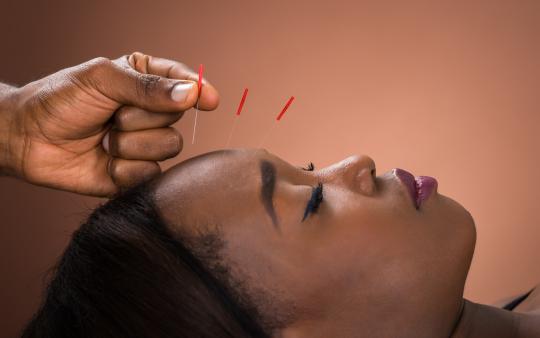Let’s face the facts: the aging process includes wrinkles. While we can ease the process by making sure we’re eating a healthy diet full of skin-friendly fats, and investing in a quality skincare routine that addresses our specific concerns, there are ways to naturally slow down (and, in some cases, reverse!) some of the signs of aging. With that in mind, before buying into botox, fillers, or harsh cosmetic peels, why not consider acupuncture?
A holistic approach
Acupuncture is widely used as a treatment in traditional Chinese medicine (TCM) to restore the body’s correct balance of qi, its energy or life-force, thus preventing ailments. It is also frequently used in the treatment of pain, tension relief, and in the healing process, as the needles create micro-traumas that increase blood flow to the injured areas, speeding up healing.
Cosmetic acupuncture involves a holistic approach which takes the entire body into consideration. By focusing on acupuncture points all over the body, the process can promote a smooth flow of qi, increase blood flow, and encourage lymphatic drainage, which help to bring oxygen and nutrients to skin cells. While typically used in the context of anti-aging, cosmetic acupuncture can also treat acne scars.
In a cosmetic acupuncture treatment, needles are placed directly into the face, as well as other acupuncture points throughout the body. These points are determined based on individual skincare concerns, but will likely fall along the stomach, spleen, large intestine, lung, heart, kidney, or liver meridians. Needles can also be placed directly into the muscle belly of specific facial muscles to stimulate muscle contraction, encouraging a gentle lift.
Skin in traditional Chinese medicine
In TCM, a meridian is the path through which qi flows, and which correlates to TCM organs. Your condition or disorder will depend on which TCM organ is disrupted. According to traditional Chinese medicine, these meridians contribute the most to the flow of qi to your face. One of cosmetic acupuncture’s most stunning features is its ability to encourage collagen growth, a protein our body makes that helps with structure. It keeps our skin feeling tight, plump, and fab, and the more we produce, the more it fills in fine lines and wrinkles, ultimately reducing their appearance.
The skin is the body’s largest organ and can be an excellent barometer of overall health! Not only does the skin provide protection, it also plays a role in temperature regulation, and in the synthesis of vitamin D! There are three layers of skin: the epidermis, the dermis, and the hypodermis. In cosmetic acupuncture, the focus is predominantly on the dermis because it contains connective tissue, collagen, hair follicles, muscles, nerves, and blood vessels.

How cosmetic acupuncture works
The cosmetic acupuncture process begins with a full facial cleanse to remove dirt, debris, and oils. Gua sha, a technique used to scrape the skin and stimulate microcirculation, is then applied to promote both blood flow and lymphatic drainage. Facial cupping comes next, to further stimulate microcirculation, the circulation of qi, and to create microtrauma within the tissue to instigate healing. Don’t worry: facial cupping is much more gentle than the cupping used on the body, and won’t leave big bruises on your face! The needles are then inserted into the face and body, and left for a prescribed amount of time, which varies from person to person. The needles are removed, the skin is generously moisturized, and a jade roller is applied to reduce puffiness and cool down the skin.
Most patients typically require about 15 sessions of cosmetic acupuncture in order to see full results. While weekly sessions are expected at the beginning of the process, they eventually become maintenance sessions of one treatment per month or less. It’s important to note that treatment should not be done daily, as it may overstimulate the skin’s melanocytes (the cells that create melanin) potentially leading to skin discolouration.
Vitamin tips for skin health
Adding a few quality supplements into your daily routine may also be helpful to maximize the benefits of cosmetic acupuncture.
Collagen
Collagen can be beneficial in replacing depleted collagen levels that happen as we age. Opt for a dermal collagen peptide (collagen types I and III), as they are more readily bioavailable than full collagen molecules.
Vitamin C
Vitamin C is a cofactor in the synthesis of collagen as well as a great source of antioxidants, thus making it a stellar supplement both for encouraging collagen production and reducing oxidative stress.
Vitamin D
Vitamin D deficiency is common and can lead to dry skin, which in turn causes skin to age more quickly.
MMST
MMST encourages the body to produce its own collagen. Considered the most bioavailable source of silicon currently available on the market, MMST is plant-based, making it a good option for those avoiding meat (collagen is typically derived from animal sources).
As always, be sure to consult with your healthcare provider before starting a supplement program.
Aging gracefully can mean many things to many different people. Cosmetic acupuncture is a natural alternative that can be helpful for individuals who would like to slow down this part of the process a bit. While it shouldn’t stop us from loving every single well-earned wrinkle, it can help diminish some of the visual cues of aging we’re not quite ready for!
You may also enjoy: Using Acupuncture During Pregnancy for a Happy Healthy Baby, Clean Up Your Skincare Act, and Stay Hydrated for Healthy Skin.









